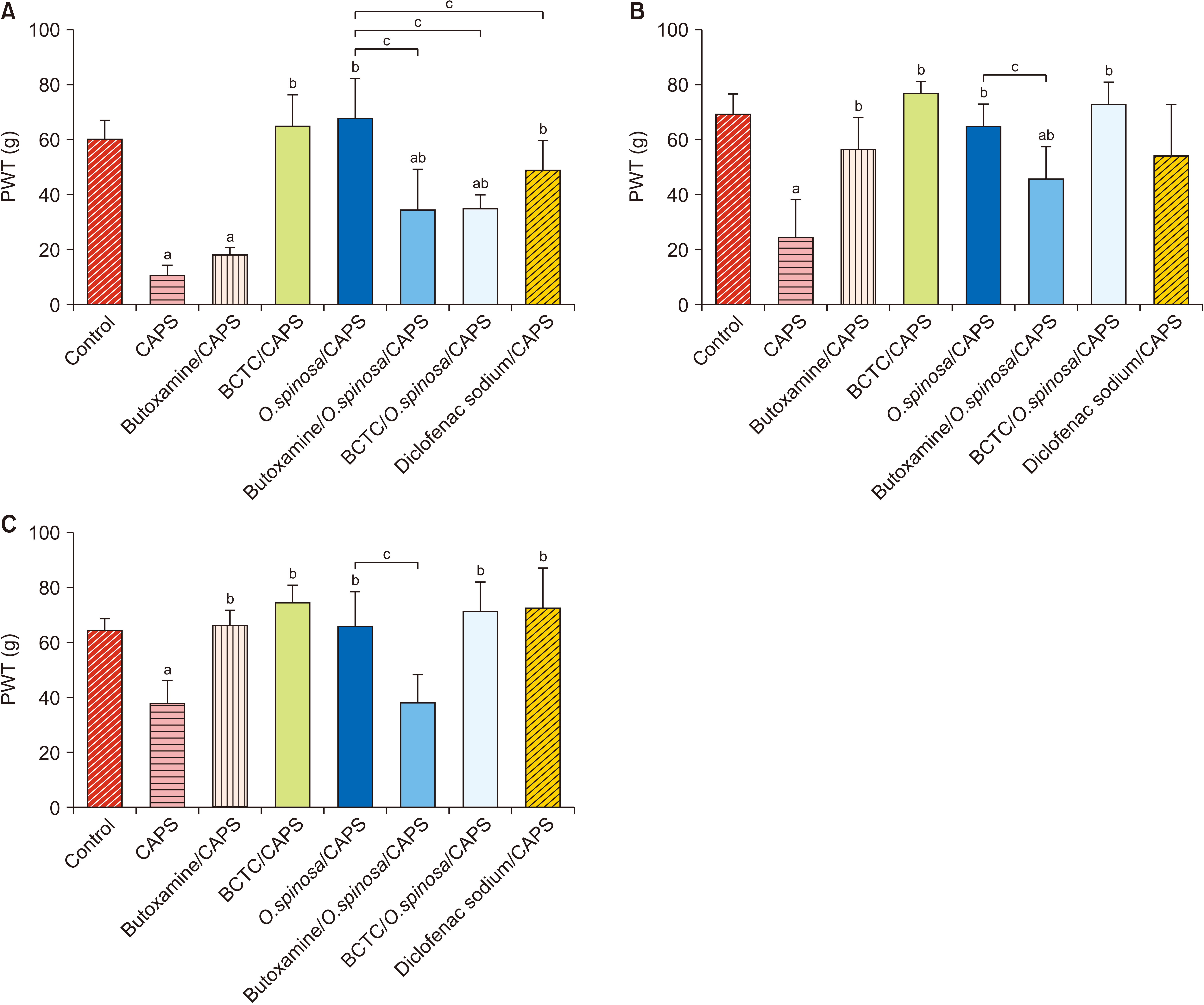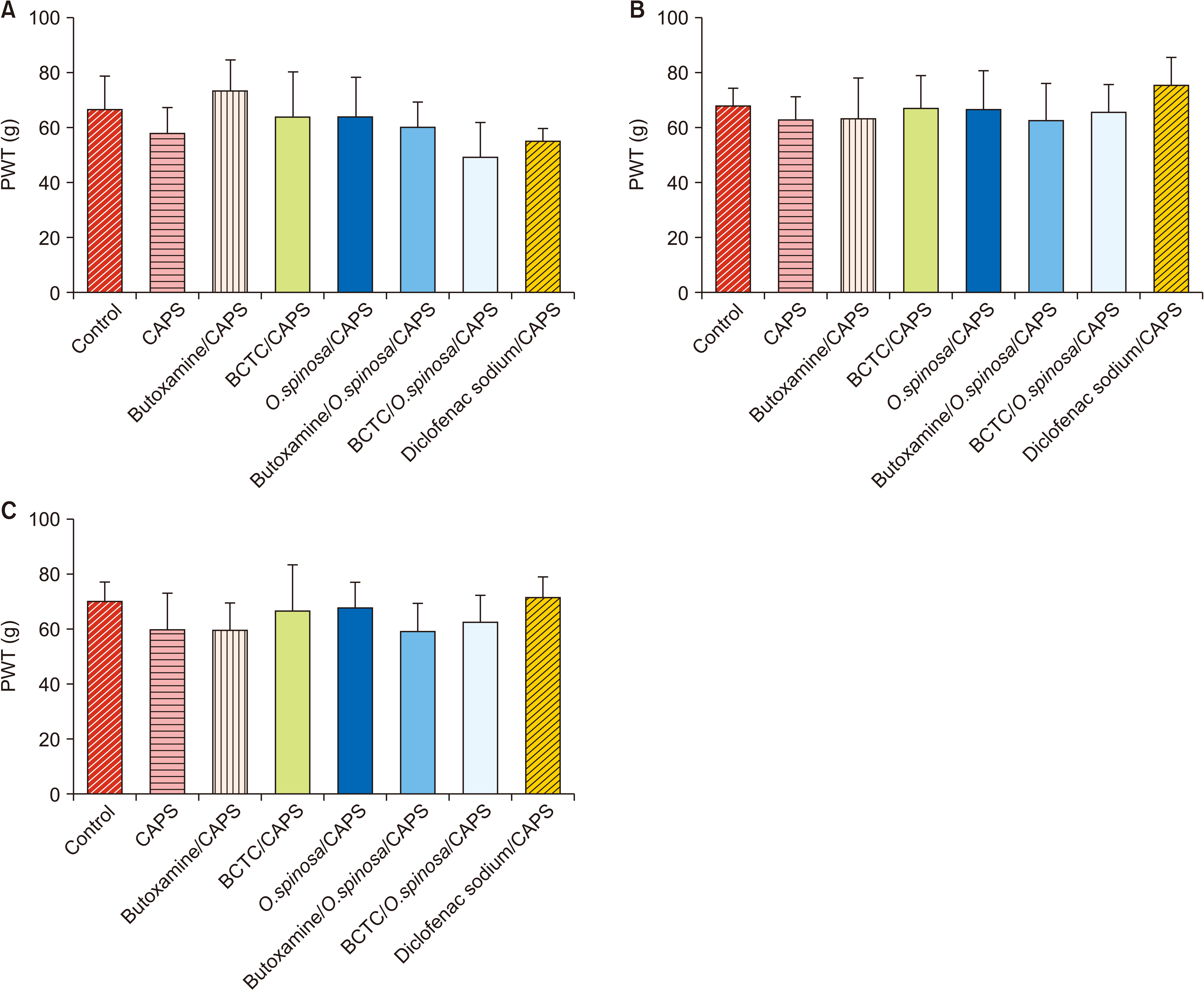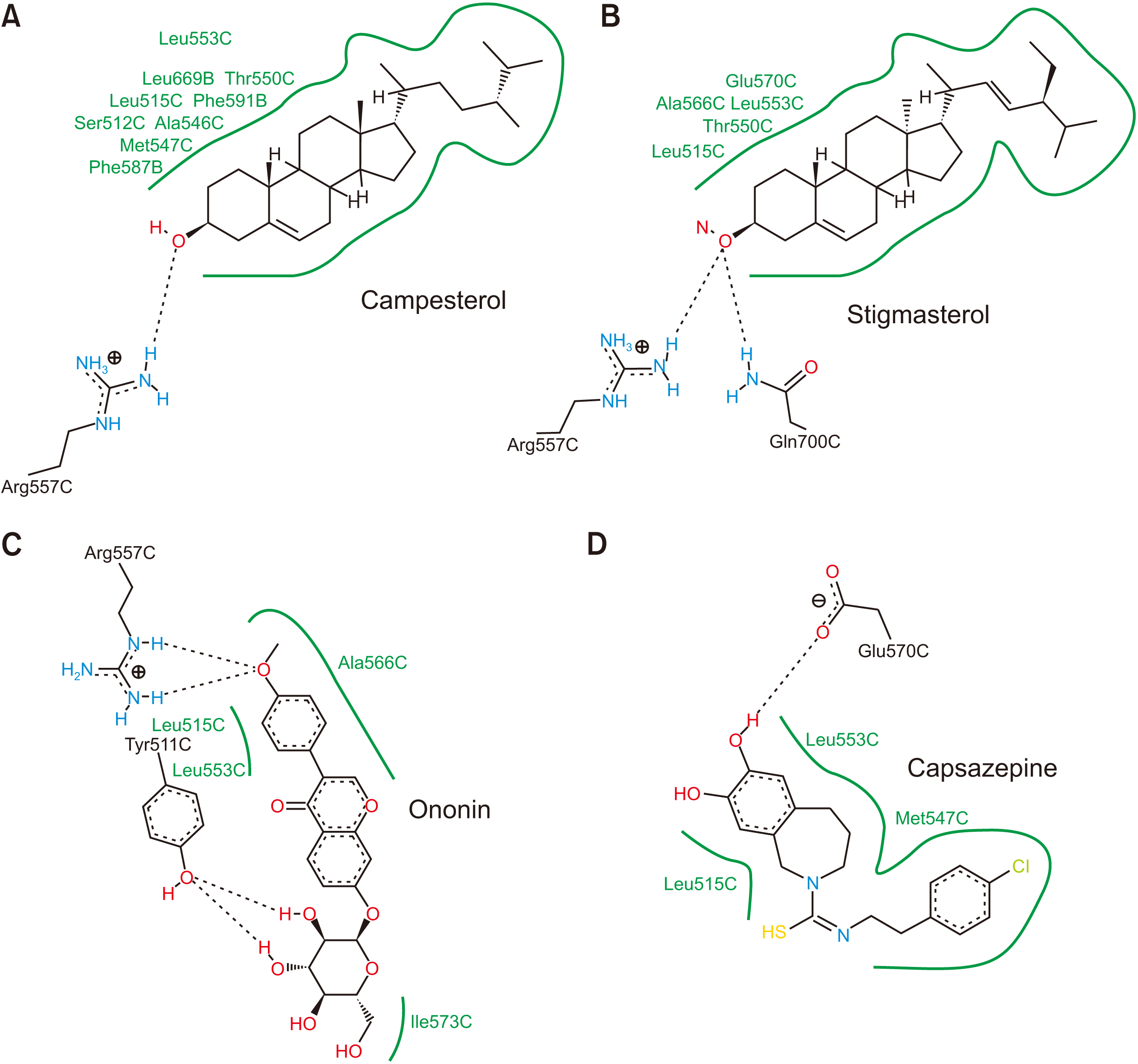1. Moran MM, Szallasi A. 2018; Targeting nociceptive transient receptor potential channels to treat chronic pain: current state of the field. Br J Pharmacol. 175:2185–203. DOI:
10.1111/bph.14044. PMID:
28924972. PMCID:
PMC5980611.

2. Cavanaugh DJ, Chesler AT, Bráz JM, Shah NM, Julius D, Basbaum AI. 2011; Restriction of transient receptor potential vanilloid-1 to the peptidergic subset of primary afferent neurons follows its developmental downregulation in nonpeptidergic neurons. J Neurosci. 31:10119–27. DOI:
10.1523/JNEUROSCI.1299-11.2011. PMID:
21752988. PMCID:
PMC3147010.

3. Gilchrist HD, Allard BL, Simone DA. 1996; Enhanced withdrawal responses to heat and mechanical stimuli following intraplantar injection of capsaicin in rats. Pain. 67:179–88. DOI:
10.1016/0304-3959(96)03104-1. PMID:
8895246.

4. Caterina MJ, Schumacher MA, Tominaga M, Rosen TA, Levine JD, Julius D. 1997; The capsaicin receptor: a heat-activated ion channel in the pain pathway. Nature. 389:816–24. DOI:
10.1038/39807. PMID:
9349813.

6. Alsalem M, Wong A, Millns P, Arya PH, Chan MS, Bennett A, et al. 2013; The contribution of the endogenous TRPV1 ligands 9-HODE and 13-HODE to nociceptive processing and their role in peripheral inflammatory pain mechanisms. Br J Pharmacol. 168:1961–74. DOI:
10.1111/bph.12092. PMID:
23278358. PMCID:
PMC3623065.

7. Wongrakpanich S, Wongrakpanich A, Melhado K, Rangaswami J. 2018; A comprehensive review of non-steroidal anti-inflammatory drug use in the elderly. Aging Dis. 9:143–50. DOI:
10.14336/AD.2017.0306. PMID:
29392089. PMCID:
PMC5772852.

8. Al-Eisawi DMH. 1998. Field guide to wild flowers of Jordan and neighbouring countries. Jordan Press Foundation;Amman:
9. Al-Snafi AE. 2020; The traditional uses, constituents and pharmacological effects of
Ononis spinosa. IOSR J Pharm. 10:53–9. DOI:
10.22159/ijcpr.2019v11i6.36338.
10. Yõlmaz BS, Özbek H, Çitoğlu GS, Uğraş S, Bayram İ, Erdoğan E. 2006; Analgesic and hepatotoxic effects of Ononis spinosa L. Phytother Res. 20:500–3. DOI:
10.1002/ptr.1891. PMID:
16619345.
11. Ergene Öz B, Saltan İşcan G, Küpeli Akkol E, Süntar İ, Keleş H, Bahadır Acıkara Ö. 2017; Wound healing and anti-inflammatory activity of some Ononis taxons. Biomed Pharmacother. 91:1096–105. DOI:
10.1016/j.biopha.2017.05.040. PMID:
28531920.

12. Al-Khalil S. 1995; A survey of plants used in Jordanian traditional medicine. Int J Pharmacogn. 33:317–23. DOI:
10.3109/13880209509065385.

13. Jaffal SM, Abbas MA. 2019; Antinociceptive action of
Ononis spinosa leaf extract in mouse pain models. Acta Pol Pharm. 76:299–304. DOI:
10.32383/appdr/99291.
15. Khasar SG, McCarter G, Levine JD. 1999; Epinephrine produces a beta-adrenergic receptor-mediated mechanical hyperalgesia and in vitro sensitization of rat nociceptors. J Neurophysiol. 81:1104–12. DOI:
10.1152/jn.1999.81.3.1104. PMID:
10085337.
17. Ferrier J, Marchand F, Balayssac D. 2016; Assessment of mechanical allodynia in rats using the electronic von frey test. Bio Protoc. 6:e1933. DOI:
10.21769/BioProtoc.1933.

18. Gao Y, Cao E, Julius D, Cheng Y. 2016; TRPV1 structures in nanodiscs reveal mechanisms of ligand and lipid action. Nature. 534:347–51. DOI:
10.1038/nature17964. PMID:
27281200. PMCID:
PMC4911334.

19. Walpole CS, Bevan S, Bovermann G, Boelsterli JJ, Breckenridge R, Davies JW, et al. 1994; The discovery of capsazepine, the first competitive antagonist of the sensory neuron excitants capsaicin and resiniferatoxin. J Med Chem. 37:1942–54. DOI:
10.1021/jm00039a006. PMID:
8027976.

20. ACD/Labs. ACD/Structure Elucidator [computer program]. Version 2018.1 Toronto (ON).
21. BIOVIA, Dassault Systèmes. BIOVIA discovery studio visualizer [computer program]. Version 2002-2021 San Diego (CA).
22. Abbas MA, Kandil YI, Abbas MM. 2021; Efficacy of extract from
Ononis spinosa L. on ethanol-induced gastric ulcer in rats. J Tradit Chin Med. 41:270–5. PMID:
33825407.
23. Fricker PC, Gastreich M, Rarey M. 2004; Automated drawing of structural molecular formulas under constraints. J Chem Inf Comput Sci. 44:1065–78. DOI:
10.1021/ci049958u. PMID:
15154775.

24. Stierand K, Maass PC, Rarey M. 2006; Molecular complexes at a glance: automated generation of two-dimensional complex diagrams. Bioinformatics. 22:1710–6. DOI:
10.1093/bioinformatics/btl150. PMID:
16632493.

25. Matsushita Y, Manabe M, Kitamura N, Shibuya I. 2018; Adrenergic receptors inhibit TRPV1 activity in the dorsal root ganglion neurons of rats. PLoS One. 13:e0191032. DOI:
10.1371/journal.pone.0191032. PMID:
29304162. PMCID:
PMC5755923.

26. Filippi A, Caruntu C, Gheorghe RO, Deftu A, Amuzescu B, Ristoiu V. 2016; Catecholamines reduce transient receptor potential vanilloid type 1 desensitization in cultured dorsal root ganglia neurons. J Physiol Pharmacol. 67:843–50. PMID:
28195064.
27. Jeske NA, Diogenes A, Ruparel NB, Fehrenbacher JC, Henry M, Akopian AN, et al. 2008; A-kinase anchoring protein mediates TRPV1 thermal hyperalgesia through PKA phosphorylation of TRPV1. Pain. 138:604–16. DOI:
10.1016/j.pain.2008.02.022. PMID:
18381233. PMCID:
PMC2593399.

28. Chakraborty S, Elvezio V, Kaczocha M, Rebecchi M, Puopolo M. 2017; Presynaptic inhibition of transient receptor potential vanilloid type 1 (TRPV1) receptors by noradrenaline in nociceptive neurons. J Physiol. 595:2639–60. DOI:
10.1113/JP273455. PMID:
28094445. PMCID:
PMC5390893.

29. Nackley AG, Tan KS, Fecho K, Flood P, Diatchenko L, Maixner W. 2007; Catechol-O-methyltransferase inhibition increases pain sensitivity through activation of both beta2- and beta3-adrenergic receptors. Pain. 128:199–208. DOI:
10.1016/j.pain.2006.09.022. PMID:
17084978. PMCID:
PMC1905861.

30. Zhu L, Zhao L, Qu R, Zhu HY, Wang Y, Jiang X, et al. 2015; Adrenergic stimulation sensitizes TRPV1 through upregulation of cystathionine β-synthetase in a rat model of visceral hypersensitivity. Sci Rep. 5:16109. DOI:
10.1038/srep16109. PMID:
26527188. PMCID:
PMC4630780.

31. Coutaux A, Adam F, Willer JC, Le Bars D. 2005; Hyperalgesia and allodynia: peripheral mechanisms. Joint Bone Spine. 72:359–71. DOI:
10.1016/j.jbspin.2004.01.010. PMID:
16214069.

32. Benarroch EE. 2016; Dorsal horn circuitry: complexity and implications for mechanisms of neuropathic pain. Neurology. 86:1060–9. DOI:
10.1212/WNL.0000000000002478. PMID:
26888981.
33. Al-Najjar BO. 2018; Synthesis, molecular docking and antioxidant evaluation of benzylidene ketone derivatives. Jordan J Biol Sci. 11:307–13.
34. Benedec D, Vlase L, Oniga I, Toiu A, Tămaş M, Tiperciuc B. 2012; Isoflavonoids from Glycyrrhiza sp. and Ononis spinosa. Farmacia. 60:615–20.
36. Lee CW. 1995; Introduction of visceral pain model to test of visceral nociception in the rats. J Korean Pain Soc. 8:25–30.
37. Julius D, Basbaum AI. 2001; Molecular mechanisms of nociception. Nature. 413:203–10. DOI:
10.1038/35093019. PMID:
11557989.

38. Walker CIB, Oliveira SM, Tonello R, Rossato MF, da Silva Brum E, Ferreira J, et al. 2017; Anti-nociceptive effect of stigmasterol in mouse models of acute and chronic pain. Naunyn Schmiedebergs Arch Pharmacol. 390:1163–72. DOI:
10.1007/s00210-017-1416-x. PMID:
28821921.








 PDF
PDF Citation
Citation Print
Print



 XML Download
XML Download